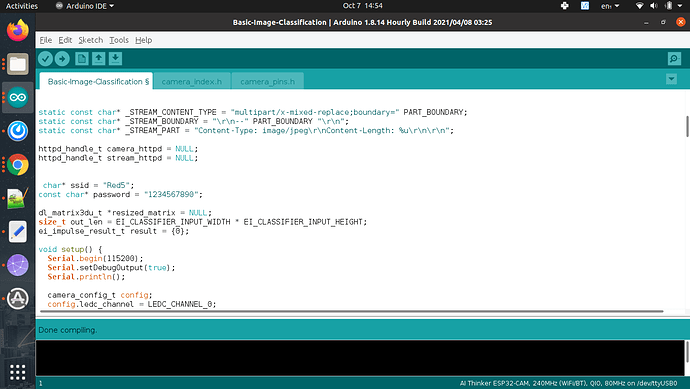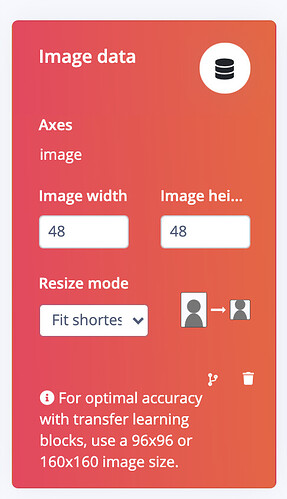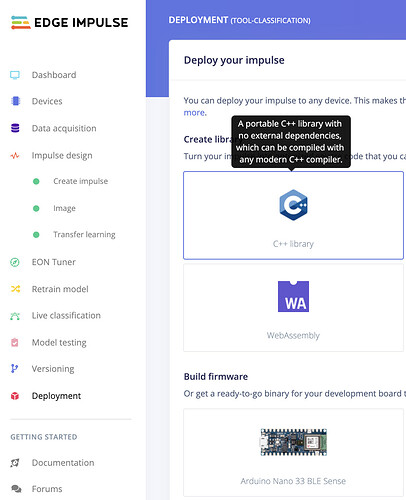Hi, @louis
Many thanks for reply …
I don’t Know what is the exact problem about why esp32cam is not connected with Arduino IDE…
Here I’m attaching my file …
Pl. have look into it.
My wifi.h file
/*
WiFi.h - Library for Arduino Wifi shield.
*/
#ifndef WiFi_h
#define WiFi_h
#include <inttypes.h>
extern "C" {
#include "utility/wl_definitions.h"
#include "utility/wl_types.h"
}
#include "IPAddress.h"
#include "WiFiClient.h"
#include "WiFiServer.h"
class WiFiClass
{
private:
static void init();
public:
static int16_t _state[MAX_SOCK_NUM];
static uint16_t _server_port[MAX_SOCK_NUM];
WiFiClass();
/*
* Get the first socket available
*/
static uint8_t getSocket();
/*
* Get firmware version
*/
static char* firmwareVersion();
/* Start Wifi connection for OPEN networks
*
* param ssid: Pointer to the SSID string.
*/
int begin(char* ssid);
/* Start Wifi connection with WEP encryption.
* Configure a key into the device. The key type (WEP-40, WEP-104)
* is determined by the size of the key (5 bytes for WEP-40, 13 bytes for WEP-104).
*
* param ssid: Pointer to the SSID string.
* param key_idx: The key index to set. Valid values are 0-3.
* param key: Key input buffer.
*/
int begin(char* ssid, uint8_t key_idx, const char* key);
/* Start Wifi connection with passphrase
* the most secure supported mode will be automatically selected
*
* param ssid: Pointer to the SSID string.
* param passphrase: Passphrase. Valid characters in a passphrase
* must be between ASCII 32-126 (decimal).
*/
int begin(char* ssid, const char *passphrase);
/* Change Ip configuration settings disabling the dhcp client
*
* param local_ip: Static ip configuration
*/
void config(IPAddress local_ip);
/* Change Ip configuration settings disabling the dhcp client
*
* param local_ip: Static ip configuration
* param dns_server: IP configuration for DNS server 1
*/
void config(IPAddress local_ip, IPAddress dns_server);
/* Change Ip configuration settings disabling the dhcp client
*
* param local_ip: Static ip configuration
* param dns_server: IP configuration for DNS server 1
* param gateway : Static gateway configuration
*/
void config(IPAddress local_ip, IPAddress dns_server, IPAddress gateway);
/* Change Ip configuration settings disabling the dhcp client
*
* param local_ip: Static ip configuration
* param dns_server: IP configuration for DNS server 1
* param gateway: Static gateway configuration
* param subnet: Static Subnet mask
*/
void config(IPAddress local_ip, IPAddress dns_server, IPAddress gateway, IPAddress subnet);
/* Change DNS Ip configuration
*
* param dns_server1: ip configuration for DNS server 1
*/
void setDNS(IPAddress dns_server1);
/* Change DNS Ip configuration
*
* param dns_server1: ip configuration for DNS server 1
* param dns_server2: ip configuration for DNS server 2
*
*/
void setDNS(IPAddress dns_server1, IPAddress dns_server2);
/*
* Disconnect from the network
*
* return: one value of wl_status_t enum
*/
int disconnect(void);
/*
* Get the interface MAC address.
*
* return: pointer to uint8_t array with length WL_MAC_ADDR_LENGTH
*/
uint8_t* macAddress(uint8_t* mac);
/*
* Get the interface IP address.
*
* return: Ip address value
*/
IPAddress localIP();
/*
* Get the interface subnet mask address.
*
* return: subnet mask address value
*/
IPAddress subnetMask();
/*
* Get the gateway ip address.
*
* return: gateway ip address value
*/
IPAddress gatewayIP();
/*
* Return the current SSID associated with the network
*
* return: ssid string
*/
char* SSID();
/*
* Return the current BSSID associated with the network.
* It is the MAC address of the Access Point
*
* return: pointer to uint8_t array with length WL_MAC_ADDR_LENGTH
*/
uint8_t* BSSID(uint8_t* bssid);
/*
* Return the current RSSI /Received Signal Strength in dBm)
* associated with the network
*
* return: signed value
*/
int32_t RSSI();
/*
* Return the Encryption Type associated with the network
*
* return: one value of wl_enc_type enum
*/
uint8_t encryptionType();
/*
* Start scan WiFi networks available
*
* return: Number of discovered networks
*/
int8_t scanNetworks();
/*
* Return the SSID discovered during the network scan.
*
* param networkItem: specify from which network item want to get the information
*
* return: ssid string of the specified item on the networks scanned list
*/
char* SSID(uint8_t networkItem);
/*
* Return the encryption type of the networks discovered during the scanNetworks
*
* param networkItem: specify from which network item want to get the information
*
* return: encryption type (enum wl_enc_type) of the specified item on the networks scanned list
*/
uint8_t encryptionType(uint8_t networkItem);
/*
* Return the RSSI of the networks discovered during the scanNetworks
*
* param networkItem: specify from which network item want to get the information
*
* return: signed value of RSSI of the specified item on the networks scanned list
*/
int32_t RSSI(uint8_t networkItem);
/*
* Return Connection status.
*
* return: one of the value defined in wl_status_t
*/
uint8_t status();
/*
* Resolve the given hostname to an IP address.
* param aHostname: Name to be resolved
* param aResult: IPAddress structure to store the returned IP address
* result: 1 if aIPAddrString was successfully converted to an IP address,
* else error code
*/
int hostByName(const char* aHostname, IPAddress& aResult);
friend class WiFiClient;
friend class WiFiServer;
};
extern WiFiClass WiFi;
#endif
My WiFi.cpp file
/*
WiFi.cpp - Library for Arduino Wifi shield.
*/
#include "utility/wifi_drv.h"
#include "WiFi.h"
extern "C" {
#include "utility/wl_definitions.h"
#include "utility/wl_types.h"
#include "utility/debug.h"
}
// XXX: don't make assumptions about the value of MAX_SOCK_NUM.
int16_t WiFiClass::_state[MAX_SOCK_NUM] = { NA_STATE, NA_STATE, NA_STATE, NA_STATE };
uint16_t WiFiClass::_server_port[MAX_SOCK_NUM] = { 0, 0, 0, 0 };
WiFiClass::WiFiClass()
{
}
void WiFiClass::init()
{
WiFiDrv::wifiDriverInit();
}
uint8_t WiFiClass::getSocket()
{
for (uint8_t i = 0; i < MAX_SOCK_NUM; ++i)
{
if (WiFiClass::_server_port[i] == 0)
{
return i;
}
}
return NO_SOCKET_AVAIL;
}
char* WiFiClass::firmwareVersion()
{
return WiFiDrv::getFwVersion();
}
int WiFiClass::begin(char* ssid)
{
uint8_t status = WL_IDLE_STATUS;
uint8_t attempts = WL_MAX_ATTEMPT_CONNECTION;
if (WiFiDrv::wifiSetNetwork(ssid, strlen(ssid)) != WL_FAILURE)
{
do
{
delay(WL_DELAY_START_CONNECTION);
status = WiFiDrv::getConnectionStatus();
}
while ((( status == WL_IDLE_STATUS)||(status == WL_SCAN_COMPLETED))&&(--attempts>0));
}else
{
status = WL_CONNECT_FAILED;
}
return status;
}
int WiFiClass::begin(char* ssid, uint8_t key_idx, const char *key)
{
uint8_t status = WL_IDLE_STATUS;
uint8_t attempts = WL_MAX_ATTEMPT_CONNECTION;
// set encryption key
if (WiFiDrv::wifiSetKey(ssid, strlen(ssid), key_idx, key, strlen(key)) != WL_FAILURE)
{
do
{
delay(WL_DELAY_START_CONNECTION);
status = WiFiDrv::getConnectionStatus();
}while ((( status == WL_IDLE_STATUS)||(status == WL_SCAN_COMPLETED))&&(--attempts>0));
}else{
status = WL_CONNECT_FAILED;
}
return status;
}
int WiFiClass::begin(char* ssid, const char *passphrase)
{
uint8_t status = WL_IDLE_STATUS;
uint8_t attempts = WL_MAX_ATTEMPT_CONNECTION;
// set passphrase
if (WiFiDrv::wifiSetPassphrase(ssid, strlen(ssid), passphrase, strlen(passphrase))!= WL_FAILURE)
{
do
{
delay(WL_DELAY_START_CONNECTION);
status = WiFiDrv::getConnectionStatus();
}
while ((( status == WL_IDLE_STATUS)||(status == WL_SCAN_COMPLETED))&&(--attempts>0));
}else{
status = WL_CONNECT_FAILED;
}
return status;
}
void WiFiClass::config(IPAddress local_ip)
{
WiFiDrv::config(1, (uint32_t)local_ip, 0, 0);
}
void WiFiClass::config(IPAddress local_ip, IPAddress dns_server)
{
WiFiDrv::config(1, (uint32_t)local_ip, 0, 0);
WiFiDrv::setDNS(1, (uint32_t)dns_server, 0);
}
void WiFiClass::config(IPAddress local_ip, IPAddress dns_server, IPAddress gateway)
{
WiFiDrv::config(2, (uint32_t)local_ip, (uint32_t)gateway, 0);
WiFiDrv::setDNS(1, (uint32_t)dns_server, 0);
}
void WiFiClass::config(IPAddress local_ip, IPAddress dns_server, IPAddress gateway, IPAddress subnet)
{
WiFiDrv::config(3, (uint32_t)local_ip, (uint32_t)gateway, (uint32_t)subnet);
WiFiDrv::setDNS(1, (uint32_t)dns_server, 0);
}
void WiFiClass::setDNS(IPAddress dns_server1)
{
WiFiDrv::setDNS(1, (uint32_t)dns_server1, 0);
}
void WiFiClass::setDNS(IPAddress dns_server1, IPAddress dns_server2)
{
WiFiDrv::setDNS(2, (uint32_t)dns_server1, (uint32_t)dns_server2);
}
int WiFiClass::disconnect()
{
return WiFiDrv::disconnect();
}
uint8_t* WiFiClass::macAddress(uint8_t* mac)
{
uint8_t* _mac = WiFiDrv::getMacAddress();
memcpy(mac, _mac, WL_MAC_ADDR_LENGTH);
return mac;
}
IPAddress WiFiClass::localIP()
{
IPAddress ret;
WiFiDrv::getIpAddress(ret);
return ret;
}
IPAddress WiFiClass::subnetMask()
{
IPAddress ret;
WiFiDrv::getSubnetMask(ret);
return ret;
}
IPAddress WiFiClass::gatewayIP()
{
IPAddress ret;
WiFiDrv::getGatewayIP(ret);
return ret;
}
char* WiFiClass::SSID()
{
return WiFiDrv::getCurrentSSID();
}
uint8_t* WiFiClass::BSSID(uint8_t* bssid)
{
uint8_t* _bssid = WiFiDrv::getCurrentBSSID();
memcpy(bssid, _bssid, WL_MAC_ADDR_LENGTH);
return bssid;
}
int32_t WiFiClass::RSSI()
{
return WiFiDrv::getCurrentRSSI();
}
uint8_t WiFiClass::encryptionType()
{
return WiFiDrv::getCurrentEncryptionType();
}
int8_t WiFiClass::scanNetworks()
{
uint8_t attempts = 10;
uint8_t numOfNetworks = 0;
if (WiFiDrv::startScanNetworks() == WL_FAILURE)
return WL_FAILURE;
do
{
delay(2000);
numOfNetworks = WiFiDrv::getScanNetworks();
}
while (( numOfNetworks == 0)&&(--attempts>0));
return numOfNetworks;
}
char* WiFiClass::SSID(uint8_t networkItem)
{
return WiFiDrv::getSSIDNetoworks(networkItem);
}
int32_t WiFiClass::RSSI(uint8_t networkItem)
{
return WiFiDrv::getRSSINetoworks(networkItem);
}
uint8_t WiFiClass::encryptionType(uint8_t networkItem)
{
return WiFiDrv::getEncTypeNetowrks(networkItem);
}
uint8_t WiFiClass::status()
{
return WiFiDrv::getConnectionStatus();
}
int WiFiClass::hostByName(const char* aHostname, IPAddress& aResult)
{
return WiFiDrv::getHostByName(aHostname, aResult);
}
WiFiClass WiFi;
Thanks in Advance …








